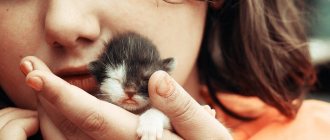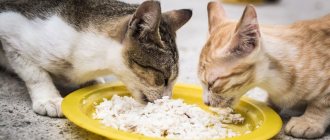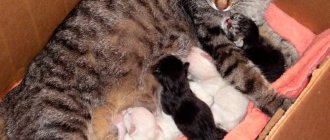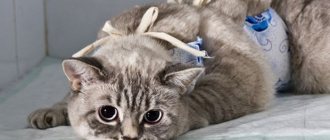If there is a new addition to your cat family, get ready for sleepless nights. And don’t even try to deceive yourself by the temporary helplessness of babies and their dependence on their mother.
Pretty soon, the fluffballs will stop crawling and confidently stand on all fours in search of adventure. At this point, you will have to answer for their safety. But knowing what time kittens begin to walk, you can protect them from possible problems, injuries and deviations.
Content
1. From newborn to full-fledged member of cat society
– Eye opening
- Teething
– Standing up and walking
– First taste of adult food
– When to give the baby to new owners?
2. How does a cat’s locomotor system develop?
3. When kittens start walking instead of crawling – what should you pay attention to?
4. Possible problems and deviations
5. Baby safety and care
Rules for caring for newborn kittens
Reliable shelter
The cat herself finds a place in which it will be convenient for her to care for newborns. Usually chooses boxes, cabinets and other dark places. A common ritual of all representatives of the cat family is to hide their cubs in secluded places.
During the period when babies begin to open their eyes, bright light disorients babies, since the lens of the eye cannot respond adequately to different lighting conditions.
If the cat does not like the place the owner has arranged, she can carry the kittens.
The nest can be built from any spacious box, having previously placed bedding there - old clothes or absorbent diapers.
Hygiene
A mother cat cannot always ensure complete cleanliness in her nest. One way or another, baby excrement ends up in the box, so it is important to change the bedding.
This also applies to kittens. They need to wipe their eyes and nose daily with a strong infusion of tea to prevent the development of microflora on the mucous membranes of these organs.
Periodically, the babies are wiped with a damp cloth - the mother cat does not always have time to lick her babies. There is no need to arrange thorough bath procedures.
Warm
It is better to leave the box with kittens in a warm place, near a radiator or heater.
From newborn to full member of feline society
Newborns weigh only 100 g. For the first 10 days they rely completely on their mother, as their senses are just beginning to develop.
Kittens are born blind, deaf and toothless. Their only reference point in space is their developed sense of smell. With its help, they can easily find mother's nipples located within 60 cm.
It takes a lot of time to develop into a full-fledged member of cat society. Each stage of growing up is unique and full of challenges, so try to give your pets all the support they need.
Eye opening
The eyes open 10-14 days after birth. The exact time depends on gender and coat length. Girls with short hair always mature earlier than boys with long hair.
Please note that all newborns have blue irises. With age, its color may change.
Teething
Milk teeth erupt on days 21-28, and after another 2 months their place is gradually taken by molars. By this point, the pets have already left the “nest”, and all poorly lying objects suffer from their new teeth.
Standing up and walking
Along with vision comes hearing. Thanks to new sensations, the world around us becomes more and more interesting.
Out of curiosity, kittens crawling on their tummy begin to make their first attempts to stand on their paws. At 3 weeks of life, they are already trying to walk, but they do it very clumsily and often fall. Their coordination improves by about 1 month.
First taste of adult food
Complementary foods are given at 1-1.5 months, when the cat’s breast milk supply begins to decrease. All food served is thoroughly boiled and crushed, achieving a liquid consistency. Solid foods are introduced into the diet only after all baby teeth have appeared.
When to give the baby to new owners?
Acquaintance with a new family should be done at 2.5-3 months. By this point, the diet of kittens is no longer different from that of an adult, so they cope much more easily with separation from their mother. This age is also optimal for vaccinations that provide immunity against the most common viruses.
New owners will have to go through 2 more stages with their mustachioed pets on the way to growing up: the first molt and puberty. After this, the active growth phase ends, and the animals are equated to adults.
When their eyes open
The process of eye opening in cubs of different breeds begins on the 5-9th day of life. Delays may occur if the baby was born weakened or the mother is not fed correctly.
Be sure to read:
Estrus in cats: how long does it last and how often does it happen, at what age, how to recognize it, how the process proceeds
Experienced breeders know breed differences. Beginning cat lovers should know that girls' eyes open earlier. Babies of long-haired breeds mature later than short-haired ones.
If the baby is 2 weeks old and its eyes have not opened, it is recommended to moisten them with strong tea or diluted boric acid and try to move them apart. In case of failure, contact an experienced felinologist or veterinarian.
How does a cat's locomotor system develop?
The musculoskeletal system consists of bones, muscles and joints. Only the hind legs are a direct continuation of the cat's skeleton. The forelimbs do not have a solid joint. They are connected to the skeleton by elastic and strong tendons. They provide smooth landings from great heights and a silent gait.
The hind legs are always stronger than the front legs, since they have to take a much larger load. They serve as support and help push off while running and jumping.
Full development of the body takes about a year, but motor function becomes available to babies already at 1 month of life. During this time they go through the following stages:
- Moving by crawling. In the first 5 days, pets move only in the direction of their mother to eat. By day 10, they begin to use their front legs. Pushing off the floor with them, the kittens ride more and more confidently on their bellies, like swimmers.
- Standing on your front paws. The first attempts are made in 1.5-2 weeks. By the end of this stage, the hind limbs also become stronger, expanding the available capabilities.
- First steps on 4 paws. When making their first movements, babies are guided by their mother. Repeating after her, they sway strongly and often fall out of the blue, but with each attempt they become closer to the goal.
- Gradual improvement of coordination to the level of adult animals. From the 3rd week, animals try to master not only walking, but also running and jumping. During the game, they can fight each other or hunt for their own tail.
The movements of whiskered pets at 1 month are very different from the timid attempts to learn to walk in the very first stages. By this age, small pets no longer fall over while running, actively play with each other and make confident jumps on low surfaces.
First month
The kitten takes its first steps at the age of two weeks. They walk unsteadily and awkwardly, and may fall and stagger. They jump rather than walk. This is how they develop and strengthen their muscles, ligaments and joints. At the end of the first month (20-25 days), the kitten begins to walk independently. During this period of life, he already actively walks, runs and jumps, plays with other kittens and his mother.
The cat is becoming more and more independent, interested in its surroundings, new smells and objects, and wants to explore every corner. He already knows how to jump on chairs and bedside tables, and is starting to eat solid food. From this moment on, he can be accustomed to socialization (contact with people, children).
Some breeders are ready to separate cats from their mother cat and give them to other families. But this is fundamentally wrong, since until the age of 1-3 months they learn from their mother, observing her habits and actions.
When the cat stands firmly on his feet and walks, he repeats her mother cat’s actions, including going to the litter box. Therefore, at this stage it is important to start teaching him to defecate on the litter tray on his own.
At this time, the kitten gains self-control - it stops scratching and biting, and controls play time. This function is partially performed by the mother cat; if necessary, she can punish the cat (slap on the nose, immobilize).
When kittens start walking instead of crawling, what should you pay attention to?
The development of each animal is individual, so there is no need to rush things. Your main tasks are surveillance and security.
Small pets can start walking at completely different times. It all depends on the state of their body at the time of birth and the quality of nutrition.
If there are weakened kittens in the litter, help them find nipples or transfer them to artificial feeding. It is more difficult for such animals to compete with hungry brothers, so they often lag behind in development.
Track your cat's motor development at each stage. Pay special attention to week 3. If, when trying to stand on its legs, the baby squeaks loudly or limps heavily, take him to the vet.
The same should be done if you continue to crawl. Such symptoms may indicate congenital or acquired pathologies.
Development of kittens (+ table)
They learn to hunt by watching the cat, and often practice with prey that the cat specially brings to them in a box.
Toilet training kittens.
During the first few weeks of life, the cat licks the kittens, stimulating urination and defecation. At about one month of age, kittens begin to need to bury the place where they went to the toilet.
At first, kittens use the litter box as a place to play, but gradually, by about six weeks of age, they begin to use it for its intended purpose. Small boxes, such as food trays with low sides, are quite suitable for kittens to use for the toilet. By imitating a cat, kittens usually easily acquire the necessary skill. Kittens' litter is changed daily.
Kittens sharpen their claws.
Imitating a cat, at the age of three weeks, kittens already learn to scratch a post. This column must be stable and located in an easily accessible place. Already at this time, you should ensure that they are not used to scratch other surfaces. Once kittens understand where to sharpen their claws, they follow this behavior pattern quite consistently.
Home » Cats » Kittens » kitten care
Possible problems and deviations
Treatment of the problem must begin immediately after its appearance. Otherwise, the pet may remain disabled.
Pain and weakness of the limbs are characteristic of the following pathologies:
- hip dysplasia, expressed in abnormal tissue development;
- liver diseases complicated by neurological disorders;
- acute intoxication;
- primary (arthritis) and secondary (trauma) dysfunctions of the musculoskeletal system;
- rickets, characterized by softening of the bones;
- malignant neoplasms.
The risk group includes Maine Coons. Due to active growth and large dimensions, 23% of representatives of this breed suffer from dysplasia. Their weight gain outpaces the development of joints, so the body simply cannot cope with the load placed on it. Also, this pathology can be inherited, and its presence must be recorded in the pedigree.
Please note that an animal suspected of being injured should not be transported. Shaking on the road can aggravate his condition, so it is better to call a doctor at home.











